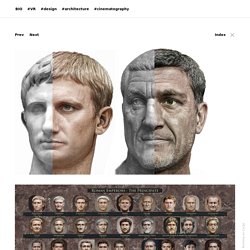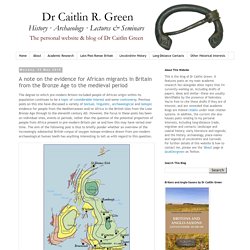

ORBIS: The Stanford Geospatial Network Model of the Roman World. Watch the Destruction of Pompeii by Mount Vesuvius, Re-Created with Computer Animation (79 AD) A good disaster story never fails to fascinate — and, given that it actually happened, the story of Pompeii especially so.

The Invention of Murder: How the Ancient Romans Codified Their Bizarre Views on Murder ‹ CrimeReads. Way back in the semi-mythical mists of Roman time, for the first three hundred years of Rome’s existence, there was no written law.

What was and wasn’t legal was up to the king, and then, when kings were booted to the kerb, to the priests. In 451 BCE, however, it was decided, for whatever reason, that this situation was not a sustainable or useful way forward for Rome. Romans being Romans, a fundamentally pragmatic people, they decided to set up a committee to deal with the situation. This committee, of ten men with consular imperium, put together ten tablets of laws and then bolted on another two tablets the following year. These were known as the Twelve Tables and they were carved into either ivory or bronze and hung in the Forum Romanum so that every Roman citizen would know their rights and obligations. The Twelve Tables are now almost completely lost, existing in fragments scattered across about five hundred years’ worth of Latin literature. Do you see what’s happened here? Hear an Ancient Chinese Historian Describe The Roman Empire (and Other Voices of the Past)
Those who see the world from only one narrow point of view get called a number of things–parochial, provincial, and worse–and are encouraged to seek out other perspectives and broaden their view.

Not everyone can travel the world, but the world comes to us through immigration and the internet, restaurants and recipes. Most of us, if we are inclined, can learn about and appreciate the cultures, cuisines, and histories of others. But can we see ourselves the way that others see us? This is a harder ask, I think, especially for Americans, who are used to the world coming to us and to defining the world on our terms, whether through soft power or military force. When we read about history, we might diversify our sources, taking in perspectives from writers with different ideological commitments and beliefs.
A great part of why we don’t read such histories is that we generally don’t even know they exist. Related Content: Free Courses in Ancient History, Literature & Philosophy. Take a Virtual Tour of the World's Largest Circular Tomb, Augustus' Mausoleum. Rome is renowned for its landmarks, from the grand Colosseum to the palatial Pantheon.

But these famed attractions aren’t all that the city has to offer: Just north of Castel Sant’Angelo, along the River Tiber, visitors will find the remains of a lesser-known, but still significant, monument: the Mausoleum of Augustus, the final resting place of the first Roman emperor and the largest circular tomb in the world. For much of the past 80 years, the mausoleum has stood abandoned, crumbling and closed to the public, writes Julia Buckley for CNN Travel. Today, tall trees render the mausoleum invisible from a nearby piazza. This week, however, city officials announced that a 13-year renovation of the tomb is finally set to draw to a close. The site will open to tourists on March 1, 2021, with free entrance for all through April 21—the anniversary of Rome’s founding in 753 B.C., reports Crispian Balmer of Reuters. Augustus designed an enormous tomb befitting his outsized impact on the empire. Mausoleum of Augustus. Ancient Rome's System of Roads Visualized in the Style of Modern Subway Maps.
Sasha Trubetskoy, an undergrad at U.

Chicago, has created a “subway-style diagram of the major Roman roads, based on the Empire of ca. 125 AD.” Drawing on Stanford’s ORBIS model, The Pelagios Project, and the Antonine Itinerary, Trubetskoy’s map combines well-known historic roads, like the Via Appia, with lesser-known ones (in somes cases given imagined names). If you want to get a sense of scale, it would take, Trubetskoy tells us, “two months to walk on foot from Rome to Byzantium. If you had a horse, it would only take you a month.” You can view the map in a larger format here. Via coudal Would you like to support the mission of Open Culture?
Also consider following Open Culture on Facebook and Twitter and sharing intelligent media with your friends. Related Content: Rome Reborn: Take a Virtual Tour of Ancient Rome, Circa 320 C.E. A few years ago, we featured Rome Reborn, which is essentially “a 3D digital model of the Eternal City at a time when Ancient Rome’s population had reached its peak (about one million) and the first Christian churches were being built.”

Rome Reborn offers, declared Matthias Rascher, “a truly stunning bird’s-eye view of ancient Rome that makes you feel as if you were actually there.” You may also remember our posts on video analyses of great works of art by Khan Academy’s Smarthistory. A Huge Scale Model Showing Ancient Rome at Its Architectural Peak (Built Between 1933 and 1937) The narrator of Teju Cole’s Open City, one of the better novels of memory and urban space to come along in recent years, at one point flies into New York City and remembers going to see a “sprawling scale model” of the metropolis at the Queens Museum of Art.

“The model had been built for the World’s Fair in 1964, at great cost, and afterward had been periodically updated to keep up with the changing topography and built environment of the city. It showed, in impressive detail, with almost a million tiny buildings, and with bridges, parks, rivers, and architectural landmarks, the true form of the city.” Ancient Roman Empire - Museums Victoria. ROMAN EMPEROR PROJECT - Daniel Voshart - Design / Cinematography. #design #architecture #cinematography Prev Next ✕ Index Using the neural-net tool Artbreeder, Photoshop and historical references, I have created photoreal portraits of Roman Emperors.

For this project, I have transformed, or restored (cracks, noses, ears etc.) 800 images of busts to make the 54 emperors of The Principate (27 BC to 285 AD).Print available here. Pompeii - Life and Death in a Roman Town ( Mary Beard ) Pompeii Live from the British Museum. An Interactive Map Shows Just How Many Roads Actually Lead to Rome. No one can give you exact directions to Milliarium Aureum (aka the Golden Milestone).

Just a few carved marble fragments of the gilded column’s base remain in the Roman Forum, where its original location is somewhat difficult to pinpoint. But as the image above, from interactive map Roads to Rome, shows (view it here), the motto Emperor Caesar Augustus' mighty mile marker inspired still holds true. All roads lead to Rome. To illustrate, designers Benedikt Groß and Philipp Schmitt worked with digital geographer Raphael Reimann to select 486,713 starting points on a 26,503,452 km² grid of Europe. From there, they created an algorithm to calculate the best route from each point to Rome. (It beats typing a street address into Google Maps 486,713 times.) Caitlin Green: A note on the evidence for African migrants in Britain from the Bronze Age to the medieval period.
The degree to which pre-modern Britain included people of African origin within its population continues to be a topic of considerableinterest and some controversy.

Previous posts on this site have discussed a variety of textual, linguistic, archaeological and isotopic evidence for people from the Mediterranean and/or Africa in the British Isles from the Late Bronze Age through to the eleventh century AD. However, the focus in these posts has been on individual sites, events or periods, rather than the question of the potential proportion of people from Africa present in pre-modern Britain per se and how this may have varied over time. The aim of the following post is thus to briefly ponder whether an overview of the increasingly substantial British corpus of oxygen isotope evidence drawn from pre-modern archaeological human teeth has anything interesting to tell us with regard to this question.
Notes1 This corpus is based primarily upon J. Connecting Research: The Forum · How diverse was Roman Britain? By Dr Matthew Nicholls, Department of Classics, University of Reading A heated conversation arose on social media on Wednesday surrounding the question of the racial diversity of Roman Britain, or the Roman empire more generally. The tweet from Alt Right commentator Paul Jospeh Watson, that kicked off the debate There is plenty of evidence that the Roman empire was relatively diverse, as might be expected from an empire that encouraged trade and mobility across a territory that extended from Hadrian’s Wall to north Africa, the Rhine, and the Euphrates (and which, less positively, enslaved and moved conquered populations around by force). Rome itself was a melting pot of people from all over the Mediterranean and beyond (satirical poets moan about it, and we have the evidence of tombstones). Outside Italy the Roman army in particular acted as medium for change and movement in several ways.
The Roman - Neptune War: Every Seashell. Nile shipwreck discovery proves Herodotus right – after 2,469 years. In the fifth century BC, the Greek historian Herodotus visited Egypt and wrote of unusual river boats on the Nile. Twenty-three lines of his Historia, the ancient world’s first great narrative history, are devoted to the intricate description of the construction of a “baris”. For centuries, scholars have argued over his account because there was no archaeological evidence that such ships ever existed.
Now there is. A “fabulously preserved” wreck in the waters around the sunken port city of Thonis-Heracleion has revealed just how accurate the historian was. Dr Estelle Lazer in Pompeii — Ancient History School. 8 Women of Ancient Rome Who Had Serious Political Power. Committee Meeting and Mary Beard Lecture in Rome. On 8 February, the Holberg Committee met in Rome, and Committee member Mary Beard delivered a lecture at the Royal Norwegian Embassy. Dame Hazel Genn chaired the 8 February Holberg Committe meeting in Rome, where the five Committee members met to discuss this year’s shortlist of candidates for the Holberg Prize and recommend a recipient.
The Committee was unanimous in its decision, and its recommendation was put forward to the Holberg Board. Prof. Mary Beard: "What's the Point of Ancient Rome?" Committee Meeting and Mary Beard Lecture in Rome. Did You Know?: Did Ancient Greeks And Romans Explore Iceland? Iceland did not become a permanent place of settlement until the 9th century.
The first inhabitants that built a long-term community on Iceland predominantly came from Norway, and later descendants of the original settlers were convinced that their ancestors’ exodus from the old homeland was a form of protest against the growing authority of King Harald Finehair (ruled approximately 860-940). It is clear that the Norsemen were the first settlers to turn Iceland into a long-term home. Yet, the question of if they were the first people to discover the island is another story. In fact, it is possible that Iceland may have been located by a Greek explorer as early as the 4th century BCE and that Romans had this information at their disposal during the time of the Roman occupation of Britain. What Did the Romans Eat? Food and Drink in Ancient Times. 10 Facts About the Roman Games. Watch the Destruction of Pompeii by Mount Vesuvius, Re-Created with Computer Animation (79 AD)
A good disaster story never fails to fascinate — and, given that it actually happened, the story of Pompeii especially so. Perseus Collections/Texts. Roads to Rome — Roads to Rome. Pinterest.com. Crash Course: Evolution of the Roman Military. Forum Romanum (The Roman Forum) (article) Take Back Halloween! This the floor plan with a descript… Caesar's invasion of Britain began from Pegwell Bay in Kent, say archaeologists. Resources. Ancient Romans Sources - History Skills. Veni, Vidi, Gone: A Death Map of Roman Emperors. Totalus Rankium is “a fun, informative podcast where we rank the Roman Emperors based on: fighting ability; madness; their successes; what they looked like and how long they lasted”.
For that last metric they also produced this map, showing the locations where Roman emperors expired. The Roman Roads of Britain Visualized as a Subway Map. Walk around London with someone who knows its deep history — not hard to arrange, given the way London enthusiasts treat historical knowledge as a hypercompetitive sport — and you'll have more than a few paths of "Roman roads" pointed out to you. Theconversation. When Rome Ruled Egypt.
How Archaeologists Crammed 1500 Years of Roman History Into One Map. Why Roman concrete still stands strong while modern version decays. The Roman Domus. How 3rd century Chinese saw the Romans. A country of “numerous minor kings” where fierce tigers and lions kill travelers. That doesn’t sound like your average description of Rome, does it? The Extent of the Roman Empire. The Roads of Ancient Rome, Reimagined as a Subway Map - CityLab. Boudica: scourge of the Roman empire. Let's travel through the ancient Roman Empire: Stanford Geospatial Network Model of the Roman World. A Very Roman Game of Thrones » Turning Points of the Ancient World. Rome's Imperial Port. Primary curriculum content « English for the Australian Curriculum. Ancient Rome's Immigration Policy Reframes Today's Refugee Question, says classicist scholar Mary Beard. Rome - Online Course. The curious tale of Roman emperors as judges.
Virtual reality helps visitors transport back in time to ancient Roman sites. Recipe – Roman bread – Primary KS2 teaching resource - Scholastic. Theconversation. Ancient Luxury and the Roman Silver Treasure from Berthouville. Roman legionary's clothing, armour and equipment. Virtual Roman House 2. Stephen Biesty - Illustrator - Exploded Views - Roman Forum. Make a Roman Fibula Brooch - Without a Torch!
Roman Houses and Villas. Romatre project - Roman villa, Auletta. The Ancientvine Domus. 3d max roman villa rustica. A glimpse of teenage life in ancient Rome - Ray Laurence. These Photos of Pompeii Show Slice of Ancient Roman Life that Was Buried Under 20 Feet of Ash - History Daily. 360° Gladiatoren im Kolosseum. Secrets of Lost Empires. Rome Reborn 2.2: A Tour of Ancient Rome in 320 CE. Ancient Rome for Kids - The Roman Empire Facts. A glimpse of teenage life in ancient Rome - Ray Laurence. Primary History - Romans. Ancient Rome - Middle School History for Kids. A History of Ancient Rome. The Roman Empire. Ancient Rome for Kids. History - Ancient Worlds. Rome Reborn 2.2: A Tour of Ancient Rome in 320 CE. Rome: Ancient Supercity Infographic. Discover Ancient Rome in 3D using Google Earth. ORBIS. Gracchi Brothers.